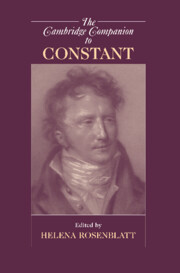Book contents
15 - Eclipses and Revivals Constant’s: Reception in France and America 1830-2007
Published online by Cambridge University Press: 28 July 2009
Summary
Like all great thinkers, Constant expressed ideas that would transcend his time and place. Convinced that he was living at the dawn of a new age, he addressed himself to the “modern” men and “friends of liberty” he hoped to influence, using very general, even universalizing, language. Throughout his many speeches and writings, he consistently sought to identify the broader patterns in history and the lessons that could be learned from them. Blessed not only with a keen eye for detail but with an uncommon capacity for analytical thinking, he had outstanding literary talents. All of this helps to explain why Constant’s writings have continued to appeal to a broad range of readers for more than a hundred and fifty years.
Perhaps even more than other great thinkers, however, Constant has also fallen victim to superficial analyses, partial readings, and misinterpretations. Many who have read and cited him have known only a small portion of his work and have paid scant attention to its original context and intended meaning. At various points of his posthumous career, Constant’s fame has therefore had little relation to his actual life, personal ambitions, and the historical purposes of his rich and multidimensional work. Instead, he appears regularly in caricature in the writings of other political theorists, who use him as a foil for their own agendas. This has resulted in there being many different “Constants,” each one reflecting the context in which he is being used more than the context in which he lived and often bearing little resemblance to the man himself.
- Type
- Chapter
- Information
- The Cambridge Companion to Constant , pp. 351 - 378Publisher: Cambridge University PressPrint publication year: 2009
- 6
- Cited by



